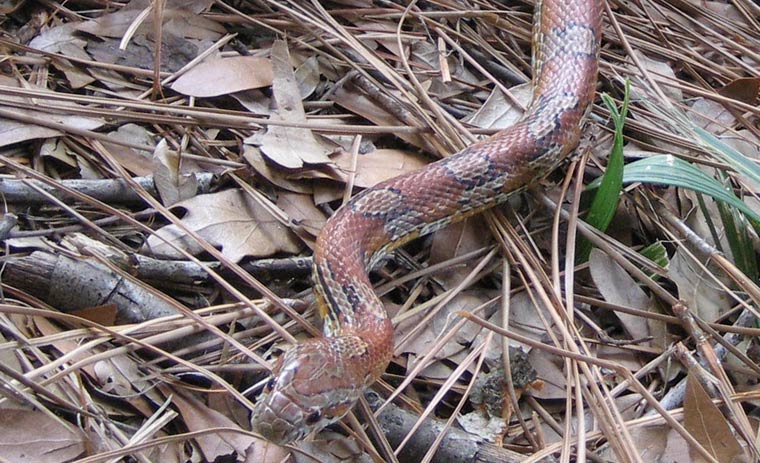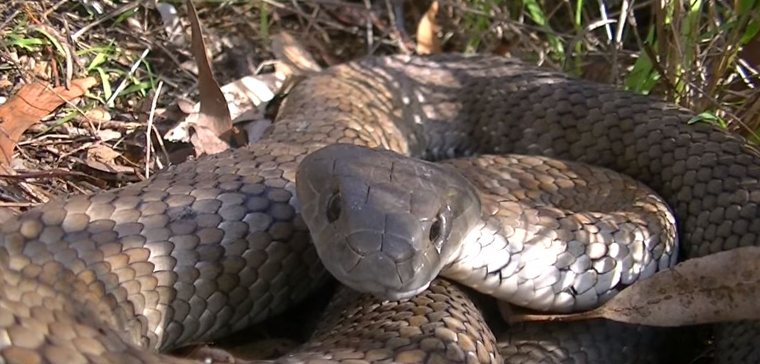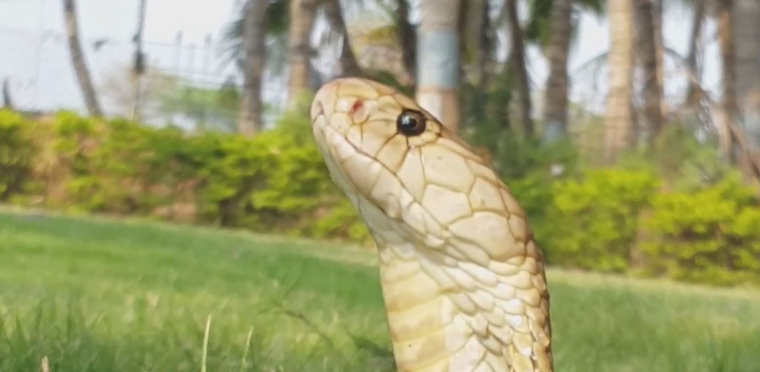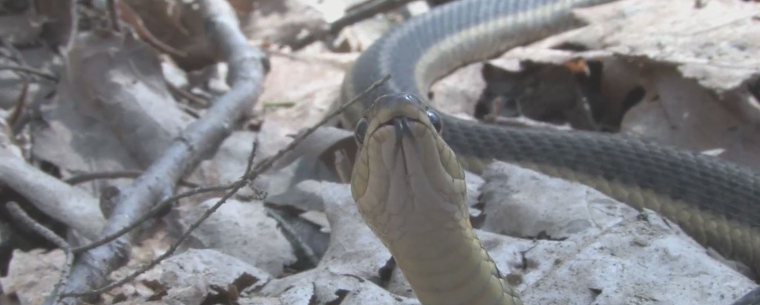-
info@aaanimalcontrol.com
Call us for help in your town
Humane Wildlife Education
Can snakes hear, do they have ears?
Need snake removal in your hometown? We service over 500 USA locations! Click here to hire us in your town and check prices - updated for year 2020.
Snakes don't have ears so how they can seemingly “hear” sounds is a topic that has driven experts and scientists for years. It was actually only rather recently that we learned more about the internal workings of a snake’s head.

For many years we thought that snakes were deaf. We then proved that wasn’t the case, so then we needed to prove exactly how they were “hearing” things. Their behavior changes to certain sound patterns, and this would only happen if they could somehow “hear”.
When humans hear, the eardrum is hit by sound waves, and these cause the small bones on the inside of the ear to vibrate. These touch tiny hairs, and nerves pick up these signals. When the brain receives the signals, they are translated into sounds.
Sometimes snakes are active at night, learn more here: Do snakes come out at night?
Snakes cannot do things in quite this way because they don’t actually have an ear, on the outside anyway. They have no outer ear, but they do have an inner ear. They have all the components necessary to make sound happen. Rather than hearing through an external ear, snakes have ears that connect to the jaw. The snake will rest its jaw on the ground as it moves around. When something else moves around on the floor also, vibrations will be sent through it, and the jaw will feel that. The rest of the process is much the same was humans - the inner still works the same way, and those nerves pick up signals which then translate the vibrations as sound to the snake. If you were to walk towards a snake, your footsteps would make the floor vibrate. The snake would sense those vibrations through its jaw, and “hear” where you are, what direction you're heading in, and much more besides.
Not so bad for an animal that we once thought was deaf, right?
Do snakes blink?
Need snake removal in your hometown? We service over 500 USA locations! Click here to hire us in your town and check prices- updated for year 2020.
Snakes do not have eyelids, so it's actually impossible for them to blink. They do have a covering to protect them, called brilles or, more hilariously, spectacles. Not quite the same kind of spectacles that you and I would wear, the ones that snake possess are actually attached to the rest of its skin, almost like just another scale.

They do have retinas, and it is these retinas that snakes are able to close when they want to sleep. It's not obvious to a human whether or not these retinas are open or closed, however, especially if that human is not clued up in the world of snake biology. Perhaps that is why the species was known as the hypnotizing animal in the Disney movie, The Jungle Book? It could just be that there is nothing hypnotizing about the snake at all, and perhaps it is only just sleeping …
(It puts a slightly different spin on things, doesn't it?)
The brilles or spectacles that sit over the snake's eyes are to protect them from all the things that the animal could come into contact with as it slithers along the ground. It doesn't have hands to wipe its eyes like we do, or paws like other animals, but the corneas beneath are incredibly sensitive, and the protective scales (of sorts) help to stop them from becoming scratched or irritated by dust and other particles.
The scales themselves don't actually sit on the corneas, instead kept separate by a thin layer of fluid, almost like tears. Just like humans, snakes have tear ducts, but they are not in the corners of the eyes. They are underneath those scale-coverings, and they are all part of the skin that is left behind when the reptile sheds too. That's why they are often observed going a milky-bluish-white color before the shedding process beings.
How do snakes communicate?
Need snake removal in your hometown? We service over 500 USA locations! Click here to hire us in your town and check prices- updated for year 2020.
Have you ever noticed that the only snake you can ‘hear' is a rattlesnake, due to the rattle built right at the end of the snake's tail. Snakes aren't known to make a noise. They don't exactly have noise-bearing tools, although they do still communicate to each other, usually in a bid to find a mate and breed successfully. Other than that, these creatures are incredibly solitary ones and have no real need to communicate on a vocal level.

Snakes don't hear airborne sounds quite like humans hear airborne sounds. Instead, for snakes, a series of sensory organs are used together to piece up the area around the animal, including other animals. Snakes have a decent sense of ‘smell', and can also taste quite well, but they also have another sense. It's a little like taste, and the animal uses its forked tongue to collect different chemical make-ups. Built with an additional organ, the Jacobson's organ, those chemicals picked up by the tongue work as a hearing sense, of sorts for the animal, and essentially gives the snake the ability to “hear” smells.
Snakes will also give off these chemicals to communicate with each other. Other animals will give off chemical signals too, and this allows the snake to figure out a number of things — how far away it is, how big it is, what direction it is moving in, whether it is alone or with others of its kind, and even whether or not it is a predator or prey.
One of the important things that snakes use to communicate with each other is pheromone signals. These come up in the chemicals that the snake pick up on. They're not the only animal to use these signals in their communication efforts, as rats are known to leave pheromones as coded chemical signs for other rats in their urine. It is not thought that snakes can pick up on or understand the pheromones of rats, however, or vice versa.
The pheromones are actually very complex and not a huge amount is understood about them. The things we do know, however, prove that snakes are incredibly complex and complicated creatures. We know that one snake can tell another snake species, age, gender, and even state of reproduction through these pheromones. Some young snakes will follow the adult pheromones trails during the winter in order to find a safe den, as is the case with some species of garter snakes. The male red-sided garter snake has even been shown to send out female pheromones in a bid to confuse other breeding males, making them very clever critters indeed. It also shows just how powerful these chemical signals are.
There are even more communication methods between snakes too. Some species of snake will growl at larger animals that they believe to be predators, and the King Cobra is one of those species. Although the noise is still technically a hiss, much the same kind of hiss as it released from other snake species when they are threatened or surprised, but just louder. You have the typical rattlesnake too, with it's audible rattle-like sound.
Snakes have many ways to communicate with each other, and even with other animals too. It would be foolish to ignore those communication efforts, particularly if you are looking at an angry, hissing snake.
How do snakes sleep?
Need snake removal in your hometown? We service over 500 USA locations! Click here to hire us in your town and check prices- updated for year 2020.
Snakes sleep with their eyes close, which is actually quite a creepy concept when you think about it. Snakes don't have eyelids, so they can't close their eyes in a conventional sense of the word. They do have a protective covering, but this doesn't cover their eyes either, when they sleep, so they really don't have much of a choice but to have their eyes open when they doze off. It is the brain that switches off when it's time for a good rest, not the non-existent eyelids on a snake's face.

What does a sleeping snake look like?
A sleeping snake looks very much like any other snake, except for one huge thing — it won't be moving. Snakes can't close their eyes, so you won't be able to tell from looking at the snake's face whether or not it is asleep. If the tongue doesn't fork out towards you, there's a good chance that the snake is asleep too. This forked tongue is what helps the snake to work out where to find food, and also how to evade predatory capture. Just because you haven't seen the tongue, however, doesn't mean that the creature is asleep. It could be basking in sunlight, in which case it probably won't want to be disturbed. It could also just be relaxing for a few moments. A snake will also become very dormant after it has eaten a big meal. The body needs to use a lot of the energy it has to digest that meal, and to break down the body. The snake will need a period of a few days, at least, to chill out and let the food do it's thing. If it were to come under predatory attack during this time, it would probably come off worse, unable to slither off as fast as it would have done before the feast had been consumed.
You probably won't be able to tell what a sleeping snake looks like, even when you have a pet snake yourself. That means working out whether or not a wild snake is asleep is going to be virtually impossible. There really aren't that many physical signs, unlike with other animals. Do not approach a snake that you believe to be sleeping. It probably isn't sleeping and there's a chance you could come off worse, particularly if the snake is a venomous one.
Where do snakes sleep?
For the most part, a snake will find a small, cosy little spot to curl up and go to sleep in, and this is definitely the case when the snake is sleeping through the winter, known as “brumation”. Although this is usually in hollowed-out trees or in the piles formed by rocks “in the wild”, there are places in your urban area that could also make the perfect sleeping spot. Under your home, for example, or even in the burrows or dens that have been left behind by other animals.
What makes a snake go to sleep?
A sleep will go to sleep for a number of reasons. The biggest one, of course, will be because it is simply tired. All animals need to rest and sleep at some point. Sleep is when a lot of the important body processes happen, and this is the case across all species. The body rejuvenates and repairs itself as you sleep, as well as many other things. Sleep is essential.
A snake will also go to sleep if it senses cold weather coming, and this is because it is a cold-blooded animal that can't regulate its own body temperature. If a snake stays outside in the cold, it will freeze. It has no choice but to find a warmer spot to curl up and go into a state of brumation. The snake slows down its metabolism to use as little energy as possible, sleeping through the cold spell.
Feeding will also make the snake very sleepy and docile, and this is because capturing an animal is hard work, especially if you haven't eaten for a long time and have spent quite a long time chasing this meal down. If the snake is a constricting species, it will have used a lot of the little energy it had left to curl up around the prey, squeezing tight in order to kill it. It will then use quite a lot of energy just digesting the meal. During the digestion period, which can last for a week or so in larger cases, the snake will be unable to defend itself properly against predators, and is unlikely to be able to overcome even the slowest and smallest of prey.
How do snakes smell their environment?
Need snake removal in your hometown? We service over 500 USA locations! Click here to hire us in your town and check prices- updated for year 2020.
Snakes do have nostrils and they can also smell pretty well, although they probably don't smell in the conventional sense of the word — the way you think they smell. They have a pretty good sense of smell, but that's to make up for the rest of their senses not quite being up to par. Let's just say that snakes aren't exactly known for their sense of smell.

Snakes actually have a slightly different sense to other animals, and they have an entirely new organ to deal with it too. This is called the “vomeronasal organ”, also frequently referred to as the Jacobson's organ. If something smells good enough to the actual nose, they will flick out their fork-shaped tongues to 'sense' the air. he tongue picks up on what are essentially chemicals signal in the air, which they then transfer back into the mouth when they retract the tongue, sending the signals to this alternative organ — the vomeronasal organ. This organ is sometimes referred to as the “nose within a nose” because of this reason — it translates the signal.
By using this action, snakes can tell a lot of information out about their surroundings. They can check out where prey is, or perhaps even predators. This gives them the advantage, in many cases, allowing them to slither off before they are detected in the cases that they know they can't win, such as with very large animals. If the animal is small enough or tasty enough to be considered prey, the tongue-to-organ action will work out the distance between snake and prey, as well as the direction the prey is traveling. Essentially, the snake uses these chemical signals to hear, taste, and smell the surroundings, all in one.
For more information, you may want to click on one of these guides that I wrote:
How much does snake removal cost? - get the lowdown on prices.
How to get rid of snakes - my main snake removal info guide.
Example snake trapping photographs - get do-it-yourself ideas.
Snake job blog - learn from great examples of snake jobs I've done.
How do snakes move?
How to identify a shed snake skin


















